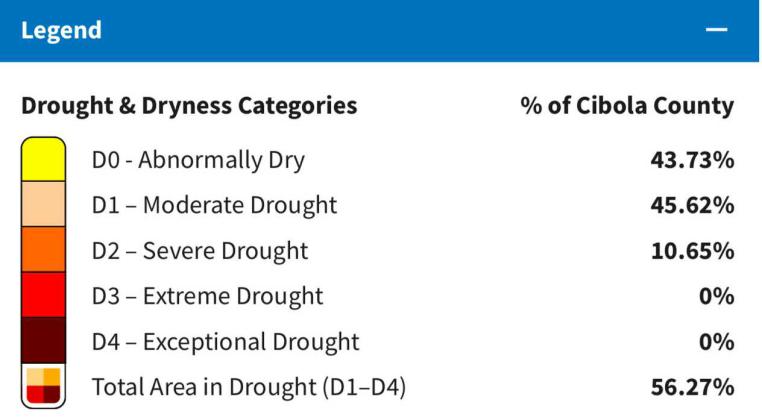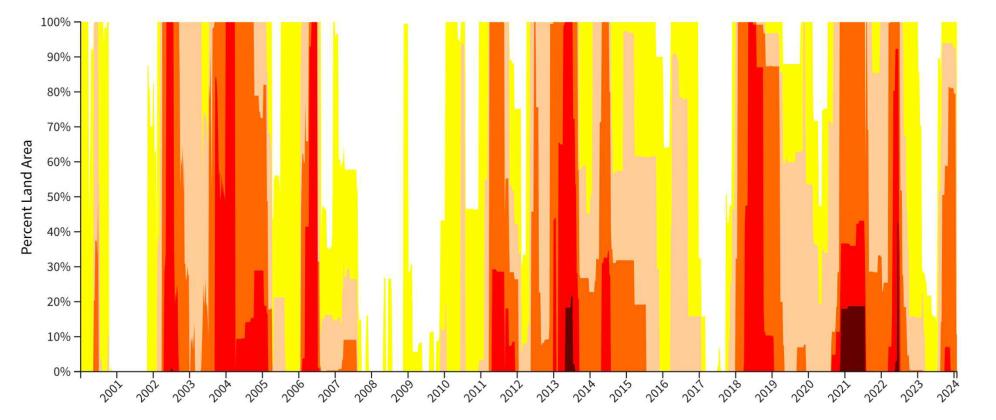Cibola County, N.M. – The parched landscapes of Cibola County, New Mexico, have borne witness to yet another challenging year, as the region grapples with severe drought conditions that have left a significant impact on its residents, livestock, and agricultural resources.
An estimated 15,313 people in Cibola County have been affected by the ongoing drought, representing 56.3 percent of the county's population. This marks a decrease of 39.1 percent when comparing data from the past month.
The region experienced its 45th wettest December on record over the past 129 years, with precipitation levels at a mere 0.18 inches below the norm. This slight deviation from average rainfall contributed to the ongoing drought conditions that have plagued the area.
Cibola County ranked as the 23rd driest year to date over the past 129 years, covering the period from January to December 2023. Precipitation levels during this period fell short by 3.02 inches from the historical average.
The U.S. Drought Monitor classifies the severity of drought using five categories, ranging from 'Abnormally Dry' (D0) to the most severe, 'Exceptional Drought' (D4).
Drought Across Cibola in December
• Abnormally Dry (D0) - 43.73 percent of the county.
• Moderate Drought (D1) - 45.62 percent of the county.
• Severe Drought (D2) - 10.65 percent of the county. This designation cuts through the middle of Cibola County in a diagonal shape, slowing southeast from the northwest.
• Extreme Drought (D3) - No areas recorded.
• Exceptional Drought (D4) - No areas recorded.
Overall, 56.27 percent of Cibola County's total area experienced drought conditions through December, ranging from D1 to D2 levels of severity.
The drought has also taken a toll on the county's agricultural sector. Approximately 252 acres of hay and 17 acres of haylage are currently affected by drought conditions in Cibola County, according to estimates.
Livestock farmers have been hit hard as well, with an estimated 5,785 cattle and 1,703 sheep currently suffering due to the prolonged drought.
The United States Department of Agriculture has officially designated Cibola County as being in drought, highlighting the seriousness of the situation and the need for assistance and resources to mitigate its impacts.
While the recent decrease in drought impact is a positive development, the challenges posed by the drought in Cibola County remain pressing. Residents, farmers, and authorities will continue to monitor the situation closely and hope for improved weather conditions in the coming months to alleviate the ongoing drought's impact on this Southwestern region.
“Exceptional Drought” Tracking
“Exceptional Drought” is the worst level of drought Cibola could be designated. Currently, there is not a piece of land in the county that is affected by “Exceptional Drought.”
2013 was the first time Cibola entered the “exceptional” category, the rating lasted for several months before ending.
While the county remained in drought, it was not given the “exceptional” rating again until 2020. The rating was assigned in December, and persisted through most of 2021.
May of 2022 saw the worst “Exceptional Drought” in county history. The United States Drought Monitor tracks the severity and length of drought across the country. The severity of 2022’s “Exceptional Drought” was starkly more severe than either of the previous two times this rating was assigned to Cibola. However, 2022’s situation lasted for a shorter amount of time than either of the previous two instances.
In 2022, Cibola suffered through the driest May over the past 128 years of drought tracking in the county, the area was suffering so badly that scientists who conduct drought tracking declared Cibola was in an “Exceptional Drought” the worst level of drought recognized by the federal government.
In June 2022, a large wildfire, the Cerro Bandera Fire, destroyed 939 acres of land in the Zuni Mountains. Fire personnel in Cibola rallied together after the fire, asking for increased fire restrictions through the month of June, especially because the Independence Day holiday was rapidly approaching and residents often celebrate with fireworks. At the time, the drought rating in Cibola was at the highest rating recognized by federal authorities who track drought across the country. Increased rainfall at the end of June, continued through August, was enough for local governments to lift some firework and open burning restrictions. Rainfall, despite expectations by meteorologists, did not stop fully but has decreased from earlier months. Cibola’s drought conditions have improved measurably since the driest days of 2022.
Drought Data
The National Integrated Drought Information System is a tool used by the National Oceanic and Atmospheric Administration; a department of the United States known by many as the team who tracks Santa Claus during the Christmas holiday. NIDIS has been tracking drought in the Cibola area since 2006, and they use other historic data and environmental sampling to get a drought reading on years prior, all the way up to 1894.
Much of the data Cibola Citizen utilizes comes from NIDIS, but also NOAA and the US Department of Agriculture and the National Agricultural Statistics Service. These entities supply data for Cibola’s acreage of hay and number of livestock.


